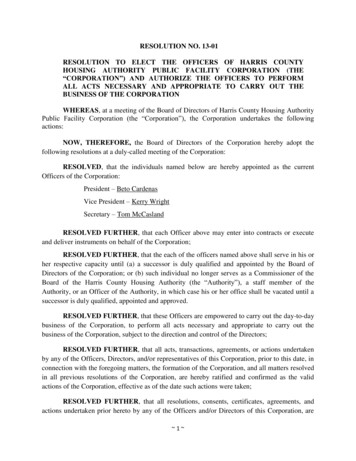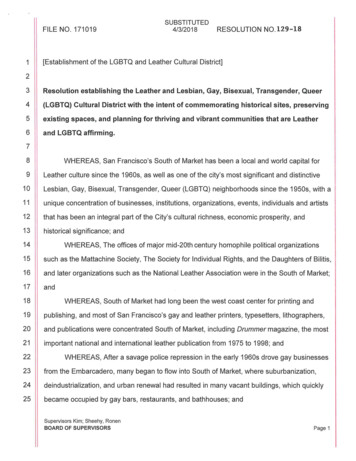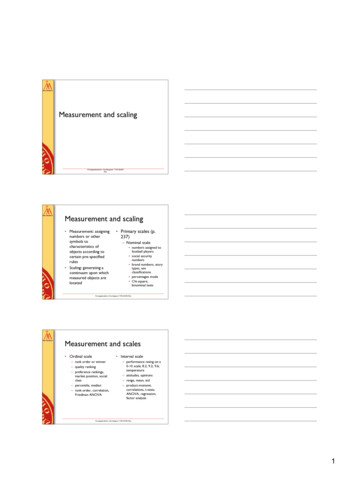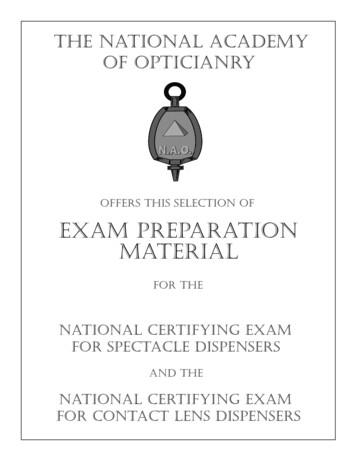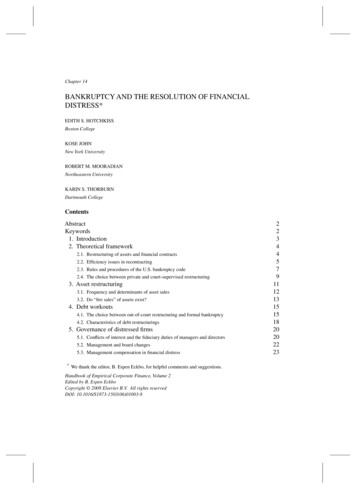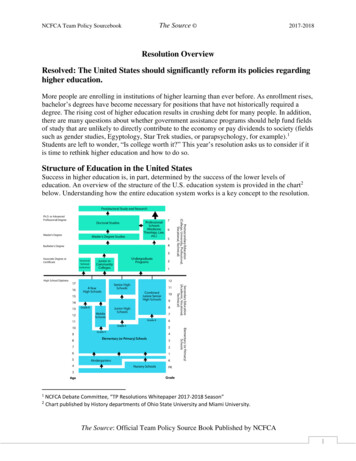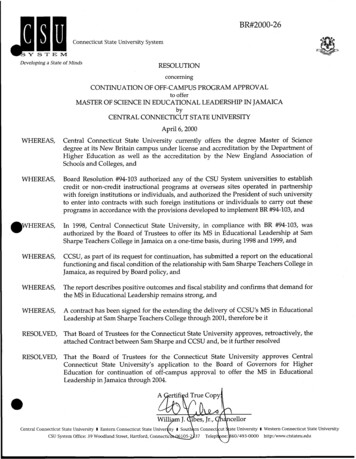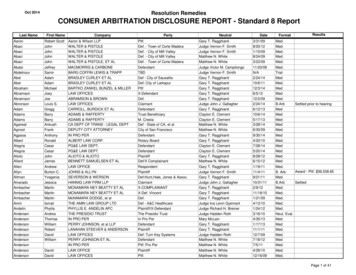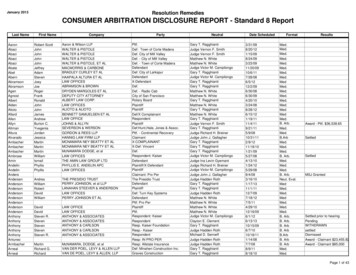
Transcription
Resolution of ABO DiscrepanciesJustin R. Rhees, M.S., MLS(ASCP)CM, SBBCM
Objectives1. Given the results of ABO typing, correctly identify ifa discrepancy exists and if the source is most likelyin the forward or reverse type.2. Describe in detail several causes of ABOdiscrepancies due to the following:a)b)c)d)Weak or missing reactivity in the reverse typing.Unexpected reactivity in the reverse typing.Weak or missing reactivity in the forward typing.Unexpected reactivity in the forward typing.3. Describe appropriate follow-up testing that isnecessary in the resolution of ABO discrepancies.
ABO Discrepancies A very important part ofpretransfusion testinginvolves detection,recognition, andresolution of ABOdiscrepancies. Discrepant results mustbe identified and theunderlying causesinvestigated.
Troubleshooting Steps Step 1: Repeat the test.– Technical errors Specimen mix-upForgot to wash cellsIncorrect cell suspensionFailure to add reagents or sampleMissed hemolysis reaction (read as negative)Didn’t follow procedureIncorrect centrifugationIncorrect interpretation Step 2: Request a new specimen.
Troubleshooting Steps Read the Forward Type first.– Note: the Forward Type reactions may not be correct Look at the strongest reactions.– The strong vs. weak reactions can provide important clues. Any time you encounter a discrepancy of any kind:– 1.) Repeat the test to rule out technical errors.– 2.) If the results are the same, record the result as:Discrepant.Only type O, Rh-compatible blood should be issued until the investigation iscompleted.– 3). ALL discrepancies must be investigated and resolvedbefore the correct ABO type can be resulted.
Reverse Type Discrepancies(Weak or Missing) Discrepancies in the reverse type arecommonly encountered, and are generallydue to weakly reacting or missing antibodies.Forward TypePatientResultReverse TypeAnti-AAnti-BA1 CellsB Cells03 00
Weak or missing reactivity in reversetype Age related ( 4-6 months old, elderly) Hypogammaglobulinemia Transplantation (Immunosuppressed)Investigation: Room Temperature (RT) incubation and centrifuge again. This may allow the antibodies enough time to sensitize and form a lattice. (Note: reverse type testing of of neonates is unnecessary) Record on the laboratory workup that you have done this. Remember: if it wasn’t documented, it wasn’t done!
Reverse Type Discrepancies(Extra) A2 phenotype with Anti-A1Cold-reactive alloantibody (anti-M, anti-P1, etc.)Cold-reactive autoantibodyPseudoagglutination due to rouleaux effect(hyperproteinemia) Transfusion of incompatible plasma components(mismatched platelets, etc.) Recent infusion of IVIG Serum antibody to reagent constituent
Resolution of A2 with anti-A1Reverse TypeForward TypeUnexpected Reactivity with A1 CellsAnti-AAnti-BA1 CellB Cell4 01 4 Most Anti-A reagents react strongly with A2 CellsAnti-A1 lectin reacts with A1 cells only;Is non-reactive with all other A subgroupsLectinD. biflorusPatient’sCells0No unexpected antibodies ng Cell 100 Screening Cell 200 Screening Cell 300 Auto Control00 Most standard protocols require multiple reactive A1 cells and non reactive A2 cells toprove the presence of anti-A1
Cold-reactive alloantibodyReverse TypeForward TypeUnexpected Reactivity with A1 CellsAnti-AAnti-BA1 CellB Cell4 01 4 Unexpected cold-reactive antibody detected;Perform antibody identification panelAnti-A1 lectin reacts with A1 cells only;Is non-reactive with all other A subgroupsLectinD. biflorusPatient’sCells4 AntibodyScreenI.S.(RT)AHGCheckCellsScreening Cell 100 Screening Cell 21 0 Screening Cell 300 Auto Control00 This pattern is an example of A1 with unexpected, cold-reactive alloantibody
Cold-reactive autoantibodyReverse TypeForward TypeUnexpected Reactivity with A1 CellsAnti-AAnti-BA1 CellB Cell4 01 4 Pan-reactivity at room temperatureAnti-A1 lectin reacts with A1 cells only;Is non-reactive with all other A subgroupsLectinD. biflorusPatient’sCells4 AntibodyScreenI.S.(RT)AHGCheckCellsScreening Cell 11 0 Screening Cell 21 0 Screening Cell 31 0 Auto Control1 0 This pattern is an example of A1 with cold-reactive autoantibody
Pseudoagglutination due torouleaux effectReverse TypeForward TypeUnexpected Reactivity with A1 CellsAnti-AAnti-BA1 CellB Cell4 01 4 Rouleaux usually disappears after wash stepsAnti-A1 lectin reacts with A1 cells only;Is non-reactive with all other A subgroupsLectinD. biflorusPatient’sCells4 AntibodyScreenI.S.(RT)AHGCheckCellsScreening Cell 11 0 Screening Cell 21 0 Screening Cell 31 0 Auto Control1 0 Reactions appear “stringy;” rouleaux effect can be seen undermicroscopic evaluation
Saline Replacement Set up reverse type testing as you usually would. Perform immediate spin (I.S.) centrifugation Before shaking the tubes, carefully remove all theplasma/serum with transfer pipette. Replace plasma with 2 drops of normal saline. Read reactions as you usually would. Principle of the test: if antibody-antigen latticeformation has occurred during the I.S. phase, it willremain undisturbed when you remove theplasma/serum. This should only remove interferingproteins that cause a false positive reaction.
Previous sample after salinereplacementReverse TypeForward TypePseudoagglutination disappears after saline replacementAnti-AAnti-BA1 CellB Cell4 004 AntibodyScreenI.S.(RT)AHGCheckCellsScreening Cell 100 Screening Cell 200 Screening Cell 300 Auto Control00
Reverse Type Discrepancies A2 phenotype with Anti-A1Cold-reactive alloantibody (anti-M, anti-P1, etc.)Cold-reactive autoantibodyPseudoagglutination due to rouleaux effect(hyperproteinemia) Transfusion of incompatible plasma components(mismatched platelets, etc.) Recent infusion of IVIG Serum antibody to reagent constituent
Case 1Reverse TypeForward TypeAnti-AAnti-BA1 CellB Cell03 3 1 What is the person’s most likely type?Which reaction(s) is/are suspect?What further test(s) should be performed?
Case 1Reverse TypeForward TypeAnti-AAnti-BA1 CellB Cell03 3 1 No rouleaux observed undermicroscopic investigation Results are most consistent with coldreactive autoantibody Perform cold panel to identifyspecificity Possible cold autoadsorption Pre-warmed ning Cell 11 0 Screening Cell 21 0 Screening Cell 31 0 Auto Control1 0
Case 2Reverse TypeForward TypeAnti-AAnti-BA1 CellB Cell4 3 1 1 What is the person’s most likely type?Which reaction(s) is/are suspect?What further test(s) should be performed?
Case 2Reverse TypeForward TypeAnti-AAnti-BA1 CellB Cell4 3 1 1 No rouleaux observed undermicroscopic investigation Results are most consistent with coldreactive alloantibody Perform antibody identification(include immediate spin (I.S.) roomtemperature (RT) phase to identifyspecificity) Antigen type reagent A1 and B cellsAntibodyScreenI.S.(RT)AHGCheckCellsScreening Cell 100 Screening Cell 21 0 Screening Cell 31 0 Auto Control00
Case 3Reverse TypeForward TypeAnti-AAnti-BA1 CellB Cell3 3 1 0What is the person’s most likely type?Which reaction(s) is/are suspect?What further test(s) should be performed?
Case 3Reverse TypeForward TypeAnti-AAnti-BA1 CellB Cell3 3 1 0AntibodyScreenI.S.(RT)AHGCheckCellsScreening Cell 100 Screening Cell 200 Screening Cell 300 Auto Control00
Case 3Reverse TypeForward TypeAnti-AAnti-BA1 CellB Cell3 3 1 0LectinD. CheckCellsScreening Cell 100 Screening Cell 200 Screening Cell 300 Auto Control00 Most likely: A2B with anti-A1
Case 4Reverse TypeForward TypeAnti-AAnti-BA1 CellB Cell3 01 3 What is the person’s most likely type?Which reaction(s) is/are suspect?What further test(s) should be ning Cell 100 Screening Cell 200 Screening Cell 300 Auto Control00
Case 4Reverse TypeForward TypeAnti-AAnti-BA1 CellB Cell3 01 3 LectinD. biflorusPatient’sCells3 AntibodyScreenI.S.(RT)AHGCheckCellsScreening Cell 100 Screening Cell 200 Screening Cell 300 Auto Control00
Case 4Reverse TypeForward TypeAnti-AAnti-BA1 CellB Cell3 01 3 No unexpected antibodies detectedPatient is A1LectinD. biflorusPatient’sCells3 AntibodyScreenI.S.(RT)AHGCheckCellsScreening Cell 100 Screening Cell 200 Screening Cell 300 Auto Control00 Check patient history for recent transfusion of ABO incompatible plasma products,infusion of IVIG, or investigate possible antibody to A1 reagent constituent.
Forward Type Discrepancies(Weak or Missing Reactions) Weak or missing RBC activity Weak ABO subgroups Leukemia/malignancy Transfusion of group O red cells Bone Marrow Transplant
Weak or missing reactivity in the forward typeAnti-AAnti-BA1 CellB Cell0003 Possible weak subgroup of A (Ax, etc.) Test cells with anti-A,B reagent May require genotype testing to confirmLeukemia/malignancies can result in temporary loss of expression ofABO antigens Check patient’s diagnosis/historyRecent massive transfusion of group O RBCs Check transfusion historyBone Marrow Transplant Possible Group A patient receiving Group O BMT Check patient’s diagnosis/history
Forward Type Discrepancies(Extra Reactions) Extra reactions in the forward type Autoagglutinins/excess protein coating the cells Unwashed cells: plasma proteins Transplantation of out-of-group Bone Marrow Acquired B antigen B(A) Phenomenon Out-of-group transfusion
Extra reactivity in the forward typeAnti-AAnti-BA1 CellB Cell1 1 3 3 Autoagglutinins/excess protein coating the cells Check patient’s diagnosis/history Waldenstrom’s Macroglobulinemia Multiple Myeloma Recent infusion of high molecular weight volume expander May need to wash cells multiple times and retest Perform Direct Antiglobulin Test (DAT) including Saline Control
Extra reactivity in the forward typeAnti-AAnti-BA1 CellB Cell1 04 4 Transplantation of out-of-group Bone Marrow Check patient’s diagnosis/history Possible Mixed Field reactivity?
Extra reactivity in the forward typeAnti-AAnti-BA1 CellB Cell4 1 04 Possible Acquired B Phenomenon Check patient’s diagnosis/history Transient Group A individuals can acquire “B-like antigen” Despite the reactivity in the forward type, the patient’sserum will not react with autologous red cells (patient doesnot have anti-A)
Extra reactivity in the forward typeAnti-AAnti-BA1 CellB Cell4 1 04 Acquired B Phenomenon can occur in the setting of infectionby gastrointestinal bacteria. Enteric bacteria can possess the deacetylase enzymecapable of converting A antigen to a B-like analog. To resolve: RBCs can be tested using a different monoclonalanti-B reagent or acidified (pH 6.0) human anti-B. Human anti-B will not react with acquired B antigen. The ability of monoclonal anti-B to recognize acquired Bshould be noted in the manufacturer’s insert.
Extra reactivity in the forward typeAnti-AAnti-BA1 CellB Cell1 4 4 0 B(A) phenotype is an autosomal dominant phenotype Weak A expression on group B red cells. Amino acid polymorphisms of the B gene are responsible:alpha-3-D-galactosyltransferase can use UDP-Nacetylgalactosamine, which adds some GalNAc to the Hantigens. Weak, extra reaction with anti-A 2
Extra reactivity in the forward typeAnti-AAnti-BA1 CellB Cell3 MF2 MF03 Possible out-of-group RBC transfusion: (Possible group B RBC transfused to group A recipient!)
Mixed Field
Mixed Field (MF) ReactionControl tubesPatient tubes
Question 1Forward TypeReverse TypeAnti-AAnti-BA1 CellB Cell1 03 3
Question 2Forward TypeReverse TypeAnti-AAnti-BA1 CellB Cell4 1 03
Question 3Forward TypeReverse TypeAnti-AAnti-BA1 CellB Cell1 3 3 0
Question 4Forward TypeReverse TypeAnti-AAnti-BA1 CellB Cell01 3 0
References Harmening DM, Ed. Modern Blood Bankingand Transfusion Practices, 6th Ed. F. A. DavisCompany, Philadelphia. 2012. Fung MK, Eder AF, Spitalnik SL, Westhoff CM.AABB Technical Manual, 19th Ed. AABB Press.2017
Cold-reactive alloantibody Anti-A Anti-B 4 0 A1 Cell B Cell 1 Lectin Patient’s Cells D. biflorus 4 Antibody Screen I.S. (RT) AHG Check Cells Screening Cell 1 0 0 Screening Cell 2 1 0 Screening Cell 3 0 0 Auto Control 0 0 Forward Type Reverse Type Unexpected Reactivity with A1 Cells Une
